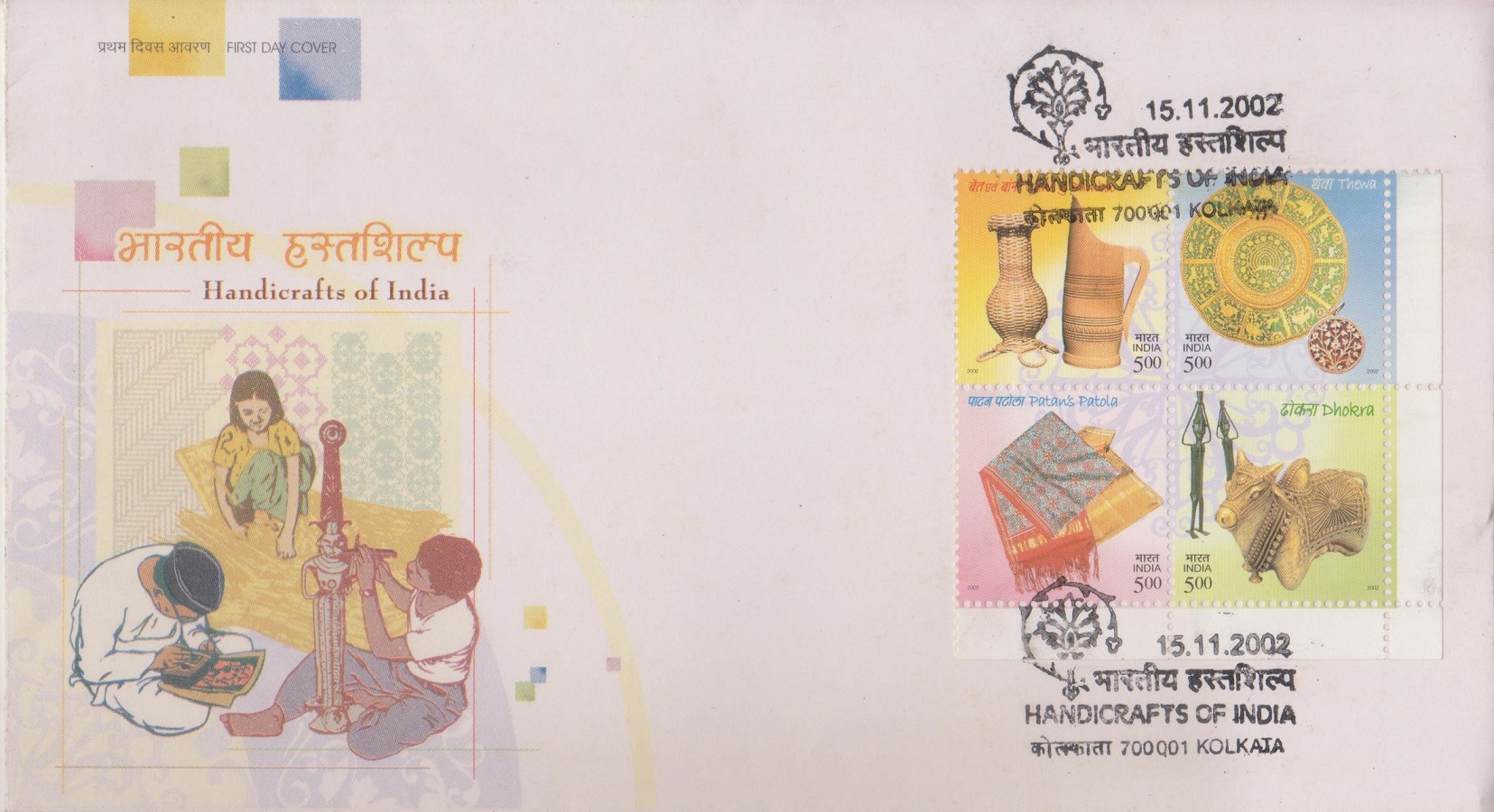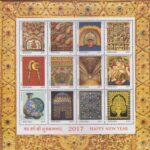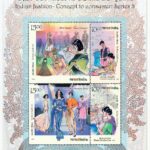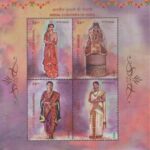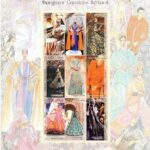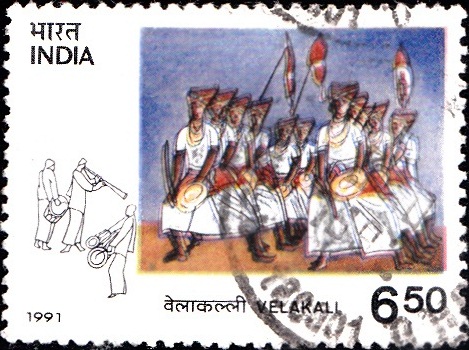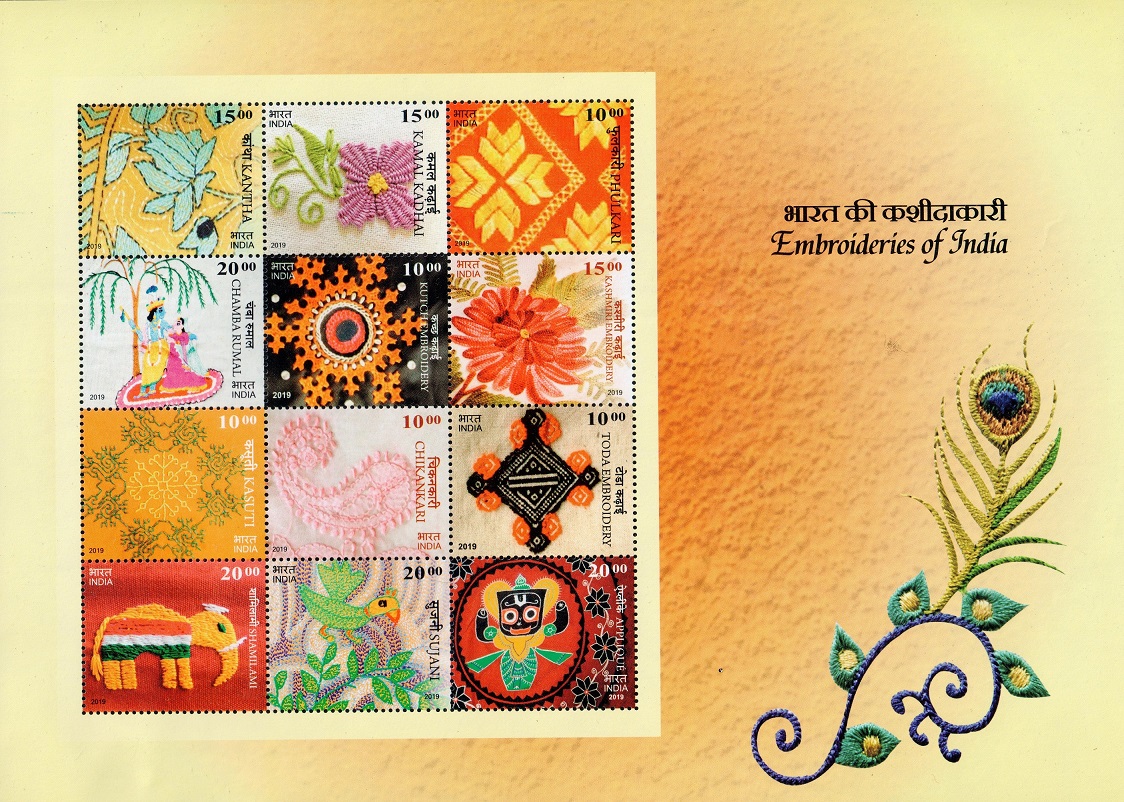
Embroideries of India
A Miniature Sheet consisting of 12 nos. of postage stamp on the Traditional Embroideries of India :
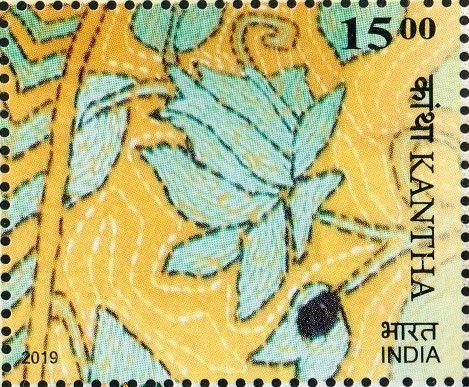
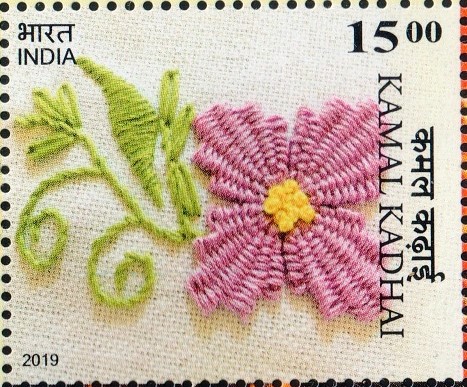
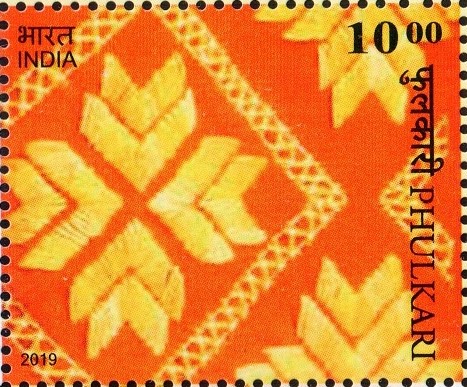
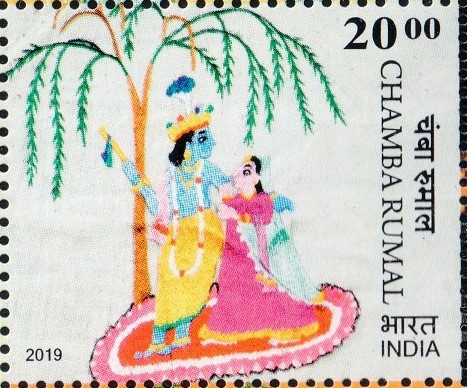
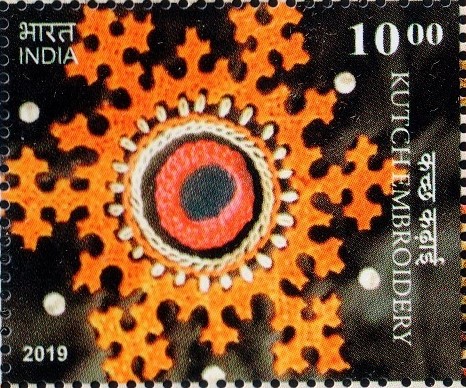
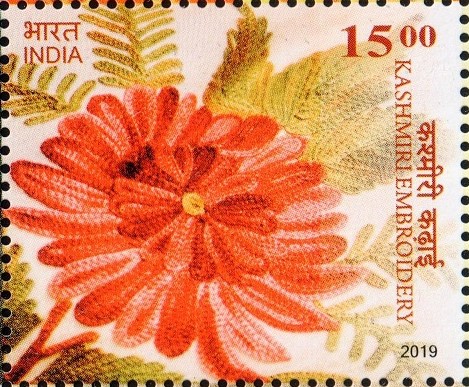
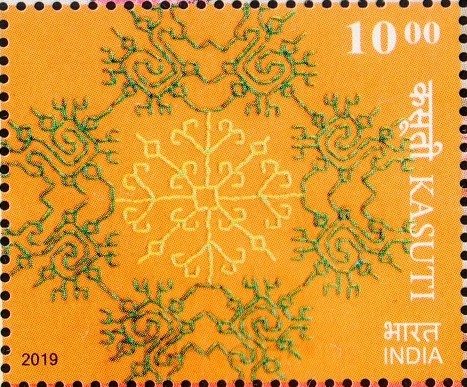
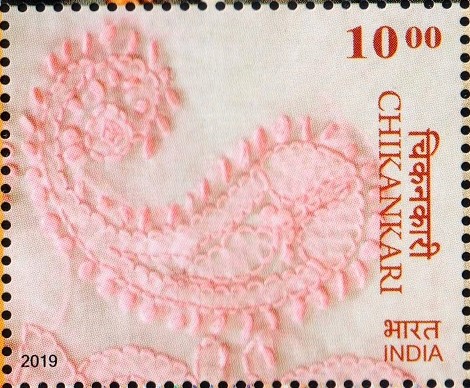
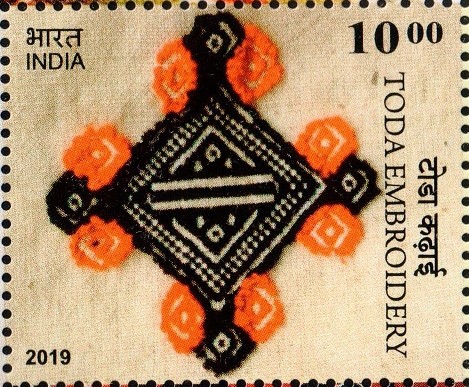
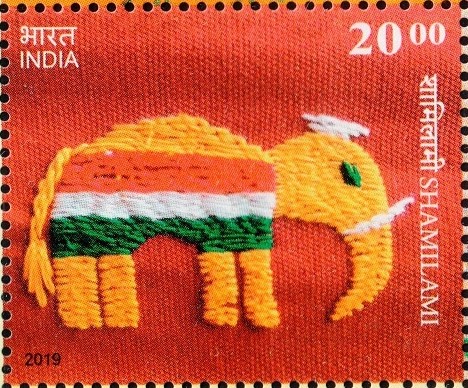
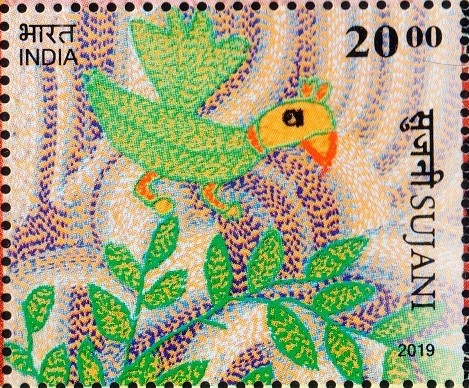
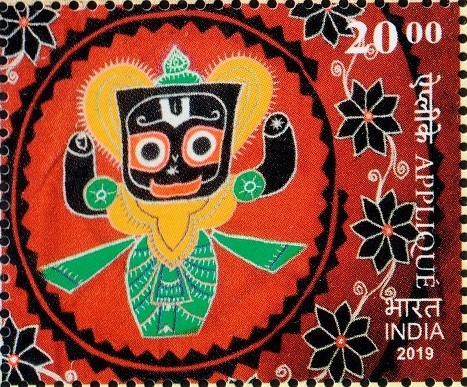
 Issued by India
Issued by India
Issued on Dec 19, 2019
Issued for : Department of Posts is pleased to release a set of 12 Commemorative Postage Stamps on Embroideries of India.
Credits :
Stamps/Miniature Sheet/Sheetlets/First Day Cover/Information Brochure/Cancellation Cachet : Ms. Gulistaan
Type : Miniature Sheet, Mint Condition
Colour : Multi Colour
Denomination : 1000 Paise (5), 1500 Paise (3), 2000 Paise (4)
Sheetlets Printed : 31250 each of 12 types
Miniature Sheets Printed : 1.10 lakh
Printing Process : Wet Offset
Printer : Security Printing Press, Hyderabad
About :
- Embroideries of India belong to different genres that vary by region and clothing style. Designs in Indian embroidery are formed on the basis of the texture and the design of the fabric and the stitch. The dot and the alternate dot, the circle, the square, the triangle and permutations and combinations of these constitute the design.
- KANTHA
- Kantha is perhaps the oldest form of Indian embroidery as it can be traced back to the 1st Century A.D. The thought behind this needlework was to reuse old clothes such as saris and dhotis and turn them into something new with a simple running stitch. Kantha evolved in the eastern regions of the Indian subcontinent, specifically in Bangladesh and in the Indian states of West Bengal, Tripura and Odisha. It is a form of embroidery often practised by rural women. There are 7 different types of Kantha stitches, each having their own unique usage; the Lep Kantha, which is used to make warm, padded quilts or the Baiton Kantha which is used on covers meant to wrap books and other precious objects. “Kantha saris” are traditionally worn by women in Bengal. Today, Kantha embroidery is popular amongst the designer fraternity.
- KAMAL KADHAI
- Kamal Kadhai is native to the state of Andhra Pradesh that primarily uses needle weaving to stitch beautiful flowers. The flower petals look like they have “steps” or “levels”. It has a 3D effect. The pattern can be used on dresses or cushion covers or making other household stuff like bed sheets, pillow covers, etc. This style of embroidery first started amongst the rural folk about 500 years ago but later received royal patronage.
- PHULKARI
- Phulkari is the most famous rural embroidery tradition of Punjab, mentioned in the Punjabi folklore of ‘Heer Ranjha’ by Waris Shah. Its present form and popularity goes back to the 15th century, during Maharaja Ranjit Singh’s reign. Phulkari also means headscarf and it comes from the 19th century tradition of carrying an odhani or a head-scarf with flower patterns. Its distinctive property is that the base is a dull hand-spun or khadi cloth, with bright coloured threads that cover it completely, leaving no gaps. It uses a darn stitch done from the wrong side of the fabric using darning needles, one thread at a time, leaving a long stitch below to form the basic pattern. Cities famous for Phulkari include Amritsar, Jalandhar, Ambala, Ludhiana, Patiala, Nabha etc.
- CHAMBA RUMAL
- The Chamba Rumal is an embroidered handicraft that was once promoted under the patronage of the former rulers of Chamba kingdom. Earliest reported form of this rumal is the one made by Bebe Nanaki, sister of Guru Nanak Dev ji in the 16th century, which is now preserved in the Gurudwara at Hoshiarpur. Chamba Rumal is made in square and rectangular shapes on muslin, malmal, khaddar, silk etc. Using a double satin stitch for the embroidery, both faces of the cloth are concurrently stitched by a forward and backward technique to maintain uniformity of design on both faces of the rumal. After completing the embroidery, the fabric is stitched with a border of about 2 to 4 inches on all sides. The dohbratbokb method is a heritage of Kashmir, which was adopted in Basohli and Chamba, that was improved upon by adopting themes from the Mughal art of Chamba miniature paintings which flourished during the 18th and 19th centuries.
- KUTCH EMBROIDERY
- Kutch Embroidery is a handicraft and textile signature art tradition of the tribal community of Kutch District in Gujarat. Its history is traced to the 16th and 17th centuries when people migrated from countries such as Afghanistan, Greece, Germany, Iran and Iraq to Gujarat. It is also said that cobblers known as Mochis were trained in this art form by the Sufi saints of Sindh. The art form became a vocation for women of Kutch not only to meet their own clothing requirements but also to make a living, in view of severe dry and very hot conditions. It became a generational art with the skills passed on from mother to daughter. The embroidery is generally done on fabrics of cotton, in the form of a net using cotton or silk threads. In certain patterns, it is also crafted over silk and satin. The types of stitches adopted are square chain, double buttonhole, pattern darning, running stitch, satin and straight stitches. The signature effect of the colourful embroidery sparkles when small mirrors called bbhib are sewn over the geometrically shaped designs.
- KASHMIRI EMBROIDERY
- Kashmiri embroidery (also called Kashida) is used for phirans (woollen kurtas) and namdahs (woollen rugs) as well as stoles. It draws inspiration from nature- birds, blossoms and flowers, creepers, chinar leaves, mangoes, lotus, trees etc. The embroidery is done on a base of silk, wool or cotton: the colour is usually white, off-white or cream but nowadays one can find many other colours such as brown, deep blue, sky blue, maroon etc. Kashmiri embroidery is known for the skilled execution of a single stitch, often called the Kashmiri stitch which may comprise the chain stitch, the satin stitch, the slanted darn stitch, the stem stitch and the herringbone stitch.
- KASUTI
- Kasuti is a traditional form of folk embroidery practised in the state of Karnataka. Kasuti work is very intricate and sometimes involves crafting upto 5,000 stitches by hand and is traditionally made on dresswear like Sarees or Kurta. Its history dates back to the Chalukya period. The Kasuti embroidery features folk designs influenced by rangoli patterns of Karnataka, mirror work and gold & silver thread embroidery, mostly used for special occasions like weddings. Kasuti involves embroidering very intricate patterns like gopura, chariot, palanquin, lamps and conch shells. The pattern to be embroidered is first marked with charcoal or pencil and then proper needles and threads are selected. The patterns are stitched without using knots to ensure that both sides of the cloth look alike.
- CHIKANKARI
- The present form of chikan (meaning elegant patterns on fabric) work is associated with the city of Lucknow, in Uttar Pradesh. Chikan embroidery is believed to have been introduced by Noor Jahan, the wife of Jahangir. Chikan embroidery involves the use of white thread on white muslin, fine cotton, or voile, which showcases shadow work embroidery. Other colours can also be used. The artisans usually create individual motifs or butjs of animals and flowers like rose, lotus, jasmine, creepers etc. The designs are first printed onto the fabric with a mixture of glue and indigo. At least 40 different stitches are documented and include flat, raised and embossed stitches and the open trellis-like jbbij work, buttonhole stitch, French knots, running stitch etc.
- TODA EMBROIDERY
- Toda embroidery has its origins in Tamil Nadu. Locally known as “Pukhoor” meaning flower, this embroidery is an art work among the Toda pastoral people of the Nilgiri hills in Tamil Nadu. This embroidery, like Kantha, is practised by women. The embroidery adorns shawls. The shawl, called poothkuli, has red and black bands between which the embroidery is done. As Todas worship buffaloes, the buffalo becomes an important motif in the Toda embroidery. Other motifs include the sun, moon, stars etc. Both sides of the embroidered fabric are usable and both men and women adorn themselves with the embroidered cloaks and shawls.
- SHAMILAMI
- A renowned textile craft from Manipur is the Shamilami, which uses a technique that combines those of weaving and embroidery. The ethnic Meithei community practises this intricate technique used in the traditional production of Shamilami fabric, whereby motifs such as tjodohbj, inspired by the gracefulness of a silk caterpillar eating a castor leaf, decorate the fabric. The embroidery is done in dark matching shade with untwisted silk thread on the border of the phanek (a lungi or lower body wrap worn by women). Colours in dark red, plum or chocolate are usually used. The embroidery is so artistically done that it does not clash with the weave and is often mistaken for it. Angami Naga shawls have animal motifs in black. This was previously called samilamiphee (which means warrior cloth of wild animals) and was given to brave distinguished warriors by the royalty, in recognition of their prowess. Possession of Shamilami – a combination of weaving and embroidery – is considered a status symbol.
- SUJANI
- Sujani embroidery originated from the Bhusura village of Bihar. In ancient times, it was considered as a form of quilting wherein old sarees and dhotis were used as the creative canvas. The process begins with tracing down the designs on the base fabric using tracing wheel and tracing sheet. Black or brown threads are used for outlining the motifs and colourful threads are used to fill in colors in the motifs. This style of embroidery is similar to the Kantha stitch of West Bengal. Today Sujani embroidery adorns ethnic outfits like sarees, kurtas, dupattas, stoles, jackets; home décor items such as cushion covers, bedspreads, wall hangings etc. The Sujani is not merely a traditional craft, it is also a way to convey social and political messages.
- APPLIQUÉ
- Appliqué is a type of embroidery that employs a smaller patch or fabric to be applied or sewed onto a larger fabric or surface to create different designs, abstract patterns or pictures. This embroidery art form came to India with the French in the 17th century. Appliqué is used extensively in quilting or adorns sarees with elaborate and vibrant looking borders. In Andhra Pradesh, the blouses and headscarves worn by the Banjara tribal women are not only embroidered but also decorated with appliqué and mirror work. Rajasthan is also known for its unique appliqué or gota, which is created by sewing edges of zari ribbon onto fabric, to create elaborate patterns.
- Text : Sh. Pallab Bose
Subscribe
Login
0 Comments


